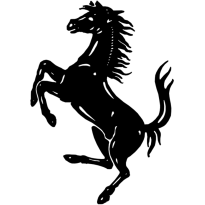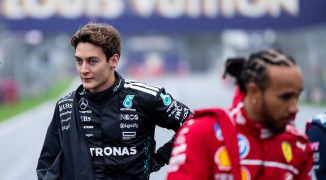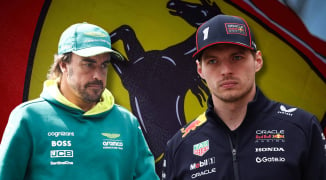Ferrari
News

Ferrari and Formula 1 are entities that go hand-in-hand with one another. Since the inception of the world championship in 1950, Ferrari has been the most successful team in the sport's history.
Alberto Ascari, Mike Hawthorn, Juan Manuel Fangio, John Surtees, Mario Andretti, Niki Lauda, Gilles Villeneuve, Alain Prost, Michael Schumacher... the list of incredible drivers to race for the Scuderia—and more often than not reign victorious—is staggering.
Despite a lean period in modern times, Ferrari still remains THE team to drive for, with such a rich and vibrant history emanating from its Maranello home.
1950-1959: Ascari, Fangio and Hawthorn
Despite the affinity Ferrari has for F1, the team had to wait until 1951 for its first victory as José Froilán González guided his car home to win the British Grand Prix at Silverstone.
One of his team-mates that day, Alberto Ascari, would take the first drivers' title by a Scuderia driver in 1952, repeating the success in 1953, meaning he is one of only two drivers to win back-to-back championships with Ferrari. His form was scintillating, winning nine races in a row across both seasons—a record only equaled by Sebastian Vettel for Red Bull in 2013.
The great Juan Manuel Fangio joined for the 1956 season following the withdrawal of Mercedes from the championship, taking three victories on the way to his fourth drivers' championship.
The final championship victory a Ferrari driver would enjoy would come in 1958 at the hands of Englishman Mike Hawthorn. Just one victory was enough for Hawthorn to become Britain's first world champion. He would retire following his success at the end of a year of tragedy, where team-mates Peter Collins and Luigi Musso died in competition.
1960-1969: Hill and Surtees
It took Ferrari four seasons from the inaugural world constructors' championship in 1958 to be crowned the best team in F1. This landmark was reached with the help of champions Phil Hill, Wolfgang von Trips, Richie Ginther, and Olivier Gendebien, who all scored points for the Scuderia.
At the 1961 Belgian Grand Prix, the quad of drivers would secure a historic one-two-three-four finish, with Hill prevailing ahead of von Trips.
Hill secured the title at the final round in Monza, where von Trips lost his life in an incident on the old banking.
Three years later, John Surtees would create history, becoming the first and only world champion on both two wheels and four. However, relationships between Ferrari and Surtees soured after a disagreement at the Le Mans 24 Hours. Surtees would be the last Ferrari world champion for 11 years.
1970-1979: Lauda and Schekter
The respite would come from Austrian Niki Lauda, one of the legendary names of the sport. In 1975, Lauda took five victories to claim the first of three personal championships.
A year later, a fearless Lauda defied the odds and made a remarkable comeback from a horrific crash at the Nurburgring Nordschleife. Despite being given his last rites on his hospital bed, Lauda returned for the Italian Grand Prix just six weeks later, with his burns still raw enough to leave bloodstains on the inside of his helmet. A heroic fourth at Monza and a podium in the US were enough to keep him in the title fight heading to the final round in Fuji.
Conditions in Japan were atrocious, and, having lapped a few times during the race, Lauda pitted to withdraw, ultimately losing out to James Hunt in one of F1's most famous seasons.
1977 would see Lauda wrap up his second and final title with Ferrari after accumulating three victories and a further seven podiums.
It would be another championship double for Ferrari to round out the decade as South African Jody Scheckter and Canadian Gilles Villeneuve claimed three victories each. Scheckter, however, had the consistency to become the last Scuderia driver to win the drivers' title for 21 years.
1980-1989: Villeneuve and Mansell in title drought
The 1980s brought a barren spell for driver titles, although the Scuderia did clinch two constructors' crowns.
The first came in the traumatic 1982 season, where the enigmatic Gilles Villeneuve lost his life at the Belgian Grand Prix, just a race after falling out with teammate Didier Pironi.
Pironi would also end his F1 career with a horrific accident, although he did survive his German Grand Prix practice incident. Patrick Tambay and Mario Andretti completed the season for the Scuderia to claim the title.
Tambay remained with the team into 1983 and was partnered by Rene Arnoux. Four race wins between each other were enough to clinch the title for the team, with Arnoux in third and Tambay fourth in the drivers' standings.
In 1988, Gerhard Berger and Michele Alboreto clinched an emotional one-two finish at Monza, just weeks after the death of Enzo Ferrari.
Nigel Mansell made history with Ferrari in 1989 as the team introduced the first semi-automatic gearbox to the sport. Mansell took victory at Rio to prove the development's worth, although McLaren was still too strong to topple across the season.
1990-1995: Prost comes and goes
After the fallout between Alain Prost and Ayrton Senna at McLaren in 1989, the Frenchman joined Ferrari in 1990. The battle between the two rivals went down to the wire in Japan, where Senna famously collided with Prost as the Ferrari swept into turn one at Suzuka. Prost had to settle as runner-up.
In 1991, tensions flared at the team, and after a tumultuous campaign, Prost was fired ahead of the season finale, departing with no wins to his name that year.
Difficulties continued for the team, with only two victories taken between 1992 and 1995 courtesy of Gerhard Berger and Jean Alesi, but brighter times were ahead.
1996-2006: The Schumacher years
Arguably the greatest driver F1 has seen, then-two-time champion Michael Schumacher joined Ferrari from Benetton ahead of the 1996 season. The car was not the finest of the team's creations, yet the German dragged it to three wins, including perhaps the greatest of his career at the Spanish Grand Prix, where, in atrocious conditions, he lapped nearly five seconds per lap faster than anyone else on track.
Controversy intervened in 1997, when Schumacher and Jacques Villeneuve battled for supremacy. At the final round at Jerez, Schumacher made contact with the Williams driver as he defended his position. The Ferrari was left stranded in the gravel, while Villeneuve continued to clinch the title.
Schumacher was three points behind Villeneuve's total but was disqualified from the championship for what the stewards saw as a deliberate attempt to take another driver out of championship contention.
Schumacher was out-battled by Mika Hakkinen and McLaren in 1998 and missed a large part of 1999 with a broken leg sustained in a crash at Silverstone, but teammate Eddie Irvine still had a chance of tasting glory. Hakkinen's victory in the final round in Japan gave the Finn his second title, with Northern Irishman Irvine just two points behind.
But Ferrari would begin an era of dominance in 2000. Five consecutive driver and constructor championship doubles for the Scuderia and Schumacher would see them hold the record for most consecutive championships until Mercedes would usurp them in the 2010s, but the brilliance displayed was staggering.
2002, for example, and Schumacher was untouchable, clinching the championship in France at round nine with seven races left. If Schumacher didn't win, Rubens Barrichello was often on hand to pick up the pieces.
In 2004, Schumacher took 13 wins and two second places out of 18 races, with Barrichello adding two of the missing five races Ferrari needed for a clean sweep.
Renault emerged as the main challenger in 2005, with Fernando Alonso leading the charge to dismantle the monopoly Ferrari had created. Only one victory would come the team's way, courtesy of Schumacher at the shambolic US Grand Prix, where Michelin-tyre runners withdrew, leaving just six cars to race.
Seven wins in 2006 were not enough to clinch a final title for Schumacher before retiring from the sport, although Felipe Massa was able to open his account with wins in Turkey and at his home race in Brazil.
Raikkonen, Alonso, Vettel, Leclerc and Sainz - 2007-Present
Kimi Raikkonen joined the team in Schumacher's place from McLaren and made an immediate impact. The Finn stole the title from his former team's driver pairing of Alonso and Lewis Hamilton, who both finished a point adrift after Raikkonen won the final race of a season that involved the espionage scandal between the two teams.
Massa almost emulated his teammate's achievements in 2008. In fact, for 30 seconds, Massa was Brazil's first champion since Ayrton Senna. But Hamilton's last-gasp overtake on Timo Glock cruelly denied Massa the title. Ferrari did manage to take its second-successive constructors' championship, though, the last time the Prancing Horse has been emblazoned on the trophy.
2009 was a disaster, with new regulations introduced as well as Massa being sidelined with a frightening injury caused by debris in Hungary. Luca Badoer and Giancarlo Fisichella both failed to wrestle any speed out of the car as the team finished fourth.
Alonso joined in 2010 and looked set to win the title, only for a roadblock in the form of Vitaly Petrov to halt his progress at the Abu Dhabi season-finale and allow Sebastian Vettel to snatch the championship away.
It was a similar sense of disappointment in 2012, where it looked as though a lap one collision in Brazil for Vettel had handed Alonso the title, only for the German to battle through the field to keep his hands on the trophy.
The 2014 introduction of the turbo-hybrid era knocked Ferrari a step backwards, losing significant pace to Mercedes, which had aced the development of the new V6 power units.
Vettel's arrival in 2015 looked to have sparked the Scuderia into life, with victories returning after a winless first year with the new engines.
The four-time champion gave the team the best hope of another driver's title in 2018 when leading at the halfway stage of the season, but errors began to mount after his now-famous crash while leading the German Grand Prix, with Hamilton eventually recovering his early deficit to become champion.
While the car challenged in 2019, Mercedes had too much in the tank over the full season, before the horror show that was 2020 knocked Ferrari way back in terms of development. The worst season the team had endured since 1980 saw them finish sixth in the standings with just 131 points.
With Charles Leclerc and Carlos Sainz piloting the recovery, Ferrari looked to have turned a corner in 2021 with two pole positions and five podiums (four for Sainz and one for Leclerc) enough to promote the Scuderia ahead of McLaren into third in the standings.
In the 2022 season, the Scuderia finished second in the constructors' championship behind Red Bull, with a total of 554 points.
Leclerc secured three wins, nine pole positions, three fastest laps, and 11 podium finishes, earning him a second-place finish in the drivers' standings with 308 points.
Meanwhile, Sainz claimed one win, three pole positions, two fastest laps, and nine podium finishes, putting him in fifth place with 246 points.
In the following year, 2023, the team was in a tight battle with Mercedes for second place in the constructors' championship.
The competition went down to the wire, with the season finale in Abu Dhabi determining the outcome.
Despite putting up a good fight, the Scuderia team was overtaken by the Silver Arrows and had to settle for third place, losing the coveted second spot by a mere three points.
The drivers' championship also saw a tight battle between Leclerc and Fernando Alonso, with both drivers finishing the season with an equal number of points (206).
However, it was Alonso who secured fourth place in the standings, thanks to his higher number of third-place finishes, while Leclerc had to settle for fifth place.
Sainz, on the other hand, finished the season in seventh place with 200 points. He was only able to claim a single race win in Singapore, which is the only win in 2023 by a non-Red Bull driver.
























 Grand Prix of Australia 2025
Grand Prix of Australia 2025  Grand Prix of China 2025
Grand Prix of China 2025  Grand Prix of Japan 2025
Grand Prix of Japan 2025  Grand Prix of Bahrain 2025
Grand Prix of Bahrain 2025  Saudi Arabian Grand Prix 2025
Saudi Arabian Grand Prix 2025  Grand Prix De Monaco 2025
Grand Prix De Monaco 2025  Gran Premio de España 2025
Gran Premio de España 2025  Grand Prix du Canada 2025
Grand Prix du Canada 2025  Grand Prix of Austria 2025
Grand Prix of Austria 2025  Grand Prix of Belgium 2025
Grand Prix of Belgium 2025  Grand Prix of Hungary 2025
Grand Prix of Hungary 2025  Grand Prix of Azerbaijan 2025
Grand Prix of Azerbaijan 2025  Grand Prix of Singapore 2025
Grand Prix of Singapore 2025  Gran Premio de la Ciudad de Mexico 2025
Gran Premio de la Ciudad de Mexico 2025  Grande Prêmio de São Paulo 2025
Grande Prêmio de São Paulo 2025  Qatar Grand Prix 2025
Qatar Grand Prix 2025  Grand Prix of Abu Dhabi 2025
Grand Prix of Abu Dhabi 2025 